The detonation combustion mode is
superior
to the deflagration mode used in today engines.
Detonation is efficient and so fast, that no engine has stand it yet!
Quasiturbine Detonation Engine
Physics: Radiation behaves like an expanding gas, and light in a compressed volume increases in intensity just as it does when approaching the focal point of a lens capable of igniting paper.
The initial chamber ambiant heat radiation is sufficient, once
geometrically compressed. Photo combustion is volumetric and occures simultaneously all across
the chamber, not driven by thermal front wave, not even shock wave. Although it is
always present, photodetonation is rarely discussed because it is undesirable in current engines, and chemists combat it with the addition of anti-knock molecules that precisely absorb the excess radiation.
Photodetonation is a blessing of cleanliness that will be allowed to dominate in future engines that support it !.
Successful - Low Power Piston - Detonation
Engine manufacturers are not much explicit about their said modern
detonation (HCCI) engine, and for good reasons: Piston Detonation
is successful only at low power, and will never be at high power
(where it should be most) with piston, because crank shaft machines are too
slow to match the very high speed of detonation. Quasiturbine AC is a much
shorter pressure pulse machine suitable for fast detonation at all power
level, due to its ability to convert early pressure into
mechanical work.
Note: Variable compression ratio technique (either mechanical on
the crankshaft, or through intake valve early closing control) is not what
is needed to achieve detonation at all power level. Rather, compression
ratio must be extremely high at all time, but mechanical pressure pulse
duration must be much shorter than what eccentric crankshaft engine can
generate.
Present Engine Limitations
There are 4 main factors detrimental to the gasoline engine efficiency:
1 - The throttle valve which absorb engine power in making intake piston
vacuum (early intake valve closing produces the same vacuum piston effect,
and valve control further result in variable piston compression ratio);
2 - The relatively low power compression ratio which reduce the expansion efficiency;
3 - The heat lost during expansion.
4 - The slow combustion, which is not quite completed by the end of the expansion (at high rpm).
The detonation (HCCI) is a major stake as its offers solutions
to these four limitations at once, by suppressing the need of trottle valve,
by increasing considerably the compression ratio,
by producing a much faster gas expansion reducing heat lost to the engine block,
and by a much faster combustion by detonation.
The next step in world engine research is to make the gas engine as
efficient as the diesel engine, and the diesel engine as clean as the gas
engine. The photo-detonation Quasiturbine AC does that and more, by conciliating
both gas (homogeneous) and diesel (non-homogeneous) engines in one extremely
efficient and clean photo-detonation mode, leading the way to a major efficiency
breakthrough!
Photo-detonation
self-fires similarly to Diesel,
but burn homogeneously, faster and cleaner.
This mode uses a « detonation chamber »
instead of a « combustion chamber ».
Photo-detonation permits efficiency gain improvements: The removal the
butterfly intake vacuum valve (engine compression breaking - which exist at all
time within gas engine), and the increase of the compression ratio (well over
the knocking and the diesel level). Because the combustion is homogeneous and
occurs in excess of air, it is as clean as an external combustion.
With our today Beau de Rocha (Otto) mode piston gas engine, about half the
gasoline used in the transportation sector is literally wasted to fight the
intake atmospheric vacuum depression generated by the carburetor or injector
manifold butterfly-valve (The engine-braking effect). This is half the pollution
of the transportation activities. Detonation Quasiturbine engine would save as
much... without all the technologies onboard hybrid vehicle which attempt to
save about half of that...
A
March 2003 - MIT study says: Improving gasoline and diesel engines is
the way to go ! Hydrogen car is no environmental panacea. The hydrogen
fuel-cell vehicle will not be better
in terms of total energy use and greenhouse gas emissions by 2020. If we
need to curb greenhouse gases, improving mainstream gasoline and diesel
engines is the way to go. These results come from an assessment of a variety of engine and fuel
technologies forecasting no real 'breakthroughs' (The Quasiturbine has
not been included in the study).
In their book
about the Quasiturbine, the inventors have used a set of 14 engine
parameters to show that none of the modern engine meets simultaneously all the
optimum general demanding criteria. Engines fail to be "all in one" compact, low
weight, low noise, zero vibration, high torque at low rpm, efficient on a wide
power range... while having homogeneous clean combustion and being multi fuel
capable... This is one objective of the detonation engine...

Quasiturbine Model AC for expander or detonation mode
Detonation is referred to as HCCI "Homogeneous Charge
Compression Ignition" or SCCI Stratified Combustion, CTI - Controlled
Auto Ignition or ATAC - Active Thermo-Atmosphere Combustion. Detonation is the enemy of the piston engine, and is
referred to as knocking / pinking. Despite all effort done to avoid
detonation in piston engine, this is a superior combustion mode which is
not discarded for the future engines. Detonation threshold objective is to achieve higher
compression ratio while maintaining homogeneous fuel mixture, hoping the piston engine
will sand it... Photo-detonation objectives is clearly to handle
detonation...
Improves the Piston
The 4 strokes piston of
our cars fires once every 2 revolutions and produces a positive torque about 17%
of the time, dragging 83% of the time. To obtain a reasonable specific power
density, we must use the combustion chamber the most often possible in every
minute, which means rotating at undesirable high regime, where it is difficult
to avoid the limitations due to gas flow and valves inertia. The high RPM also imposes
constraints which require a reduced piston course, which call for a reduction of
the crankshaft diameter and a reduction of the engine torque, and consequently a
more severe need for the gearbox and on the kinetic aspects like the flywheel,
which severely reduces the engine accelerations.
Present day gasoline fuel injector are not in the
combustion chamber.
Contrary to the Diesel, there are gasoline injectors near the intake valve,
within the vacuum intake manifold...
The intake manifold vacuum still is there, carburetor or injector
(butterfly vacuum valve is the problem, not the fuel means).
With carburetor or injector, the Otto cycle has the advantage to premix the air
and the fuel,
such as to produce after compression, a uniform pollution controllable
combustion.
Direct fuel injection in the combustion chamber is done with a spray with is
fuel rich inward, stochiometric in the periphery (too hot), and fuel lean on the outward.
Quality of this type of non-homogeneous combustion is hardly impossible to control.
There is no way out for "vacuum free intake, while having
uniform low pollution combustion",
except through detonation (intake uniform fuel mixture at atmospheric
pressure)... and the Quasiturbine short volume pulse device is designed specifically
for that... (particularly the QT-AC model).
Shaping the Pulse
Detonation research effort in piston engine goes-on for years without yet any commercial
promises. Research focuses towards finding possibilities and limitations
of the HCCI
engine, and specially towards how different parameters affect the engine
performance and emissions, without much questioning the piston concept
itself ? Future engine breakthroughs
can however append in detonation engine, where the Quasiturbine offers new
means. Quasiturbine (specially the AC model) opens the door to detonation
development by providing a
much shorter pressure tip pulse machine, with faster linear raising and falling
pressure ramps.
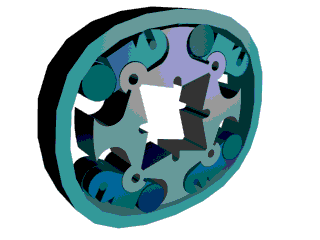
QT-AC (With carriages) is intended for detonation mode,
where high surface-to-volume ratio
is a factor attenuating the violence of detonation.
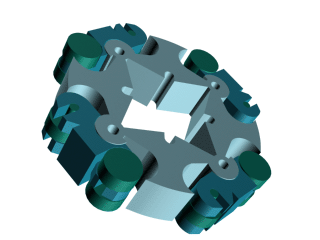
Contrary to piston-crankshaft concept confined to near sinusoidal chamber
volume pulse, the Quasiturbine is a family of engine concepts based on 7
independent geometrical parameters, which allows a multitude of designs quite
different one an other. Because the Quasiturbine can accept carriages, it is
possible to define sets of parameters which can shape "almost at will" the
chamber volume pressure pulse. To withstand the detonation, a Quasiturbine has a chamber volume pulse of 15 to 30 times shorter than piston, with rapid raising
and falling linear ramps. The QT-AC (With carriages) is
intended for detonation mode, where high surface-to-volume ratio is a
factor attenuating the violence of detonation.
Photo-detonation
self-fires similarly to Diesel,
but burn homogeneously, faster and cleaner.
This mode uses a « detonation chamber »
instead of a « combustion chamber ».

Quasiturbine Model AC for expander or detonation mode
For a look at the Quasiturbine in
Virtual Reality
(Vrml)
The Quasiturbine allows to solve modern engine developments
dilemma by two main unique characteristics, which are:
- First, by firing 8 times each two revolutions in a four strokes mode, which
allows to use the combustion chambers much more often without having to
increase the engine rpm, and without facing the fast gas flow problem, nor
the valves inertia since there is none.
- Secondly, by reaching detonation mode with its shorter tip pressure impulses with linear ramps
permitting to self-trigger the thermal and photonic ignition and to overcome
the obstacles limiting the high engine compression ratio, so increasing
the efficiency, while maintaining the uniform combustion capability and
simultaneously reducing the polluants.
Because it was conceived for thermal and photonic ignition, the
Quasiturbine cannot be considered as a "rotary piston engine", nor be
correctly characterized by the piston paradigms.
Quasiturbine Rotor Dynamic
The eccentric crankshaft machines reach their maximum
and minimum mechanical extension in synchronization with the pressure
strokes, while in the Quasiturbine, the rotor reaches it maximum and
minimum extension at half-stroke, producing a smooth kinetic transition
near Top and Bottom pressure Dead Center. Le piston atteint ses positions
extrêmes en coïncidence avec le début et la fin des cycles de pression, et
comme lui, le vilebrequin du Wankel impose aussi cette synchronisation,
qui favorise un cognement du rotor sur le stator près des points haut et
bas. Dans la Quasiturbine, les positions extrêmes du rotor correspondent à
l’élongation en losange, alors que les cycles de pressions débutent et
terminent en configuration carrée, ce qui crée une situation
particulièrement heureuse pour la continuité du mouvement de rotation et
le balancement des efforts internes sur le rotor lors du passage (sans
cognement) en configuration carrée, ce qui accentue la compatibilité avec
la photo-détonation.
Une fois la déformation du rotor lancée depuis une élongation losange sur
un axe vers une élongation sur un autre axe, le système des 4 pales
présente une inertie qui assure la continuité (sans cognement) de la
déformation lors du passage à la configuration carrée, là où sont les
principales et violentes perturbations de pression. Notons que cette
inertie de la déformation est freinée par l’action des joints de contour
sur les parois internes du stator dans la région éloignée du centre, mais
que l’effet de rappelle dynamique dû à la pression interne dans les
chambres vient aider ce freinage, voir même le dominer à certain régime.
Quasiturbine Detonation
Photo-detonation combustion mode is the fastest and
the cleanest way, driven by volumetric black body radiation density, alike
a powerful laser beam. Reference to laser light is a good way to
see it; an other way is to remember burning a piece of paper at the sun focal
point of a lens. It requires no anti-detonation fuel additive, and
piston will likely never sand it? The road to photo-detonation goes
through some deflagration, some thermo-ignition auto lit, some threshold
detonation and some supersonic detonation, all adding to radiation
process, and finally radiative combustion driven photo-detonation. This
mode is almost independent of the shape of the combustion chamber and
accepts almost any type of fuel.
Photo-detonation
self-fires similarly to Diesel,
but burn homogeneously, faster and cleaner.
This mode uses a « detonation chamber »
instead of a « combustion chamber ».
Detonation combustion mode is driven by a supersonic
choc wave or better, by radiation. It is very fast, and is generally initiated by an other combustion
mode followed by an excessive compression level.
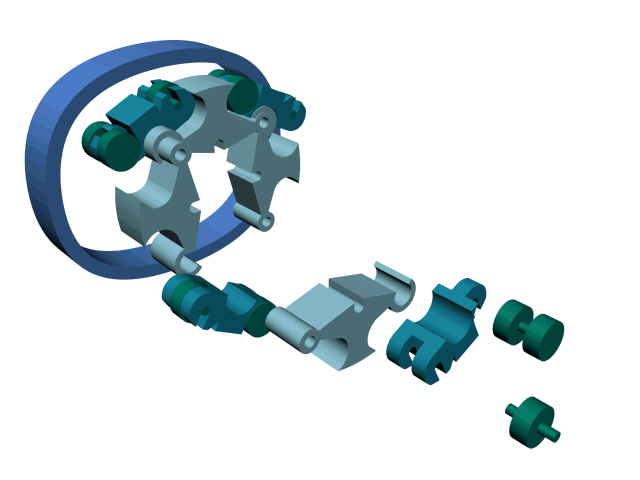
QT-AC (With carriages) is intended for detonation mode,
where high surface-to-volume ratio
is a factor attenuating the violence of detonation.
Detonation is an extremely rapid combustion, either supersonic or totally
volumetric when photon driven. Many labs have been trying to make piston engine
work in the detonation mode without serious success. The Quasiturbine family of
engines uses no sinusoidal crankshaft, and allows for carriages which permit to
shape the volume pulse more appropriately than the piston for detonation.
Quasiturbine (Model AC with carriages) is intended for detonation mode, where
high surface-to-volume ratio is a factor attenuating the violence of detonation.
In photo-detonation mode, since the combustion is driven by the radiation and
that the pressure pulse is much shorter, the shape of the combustion chamber and
its surface / volume ratio has little effect. In fact, the high ratio Surface to
Volume help attenuate the violence of combustion. Not only the photo-detonation
suppresses the energy consuming butterfly vacuum intake valve and so preserving
the engine efficiency at low power, but since it requires a much higher compression ratio,
it does increases the engine efficiency at full throttle as well.
Why Does the Quasiturbine Stand it?
Because kinetics in the vicinity of the TDC of the
"piston" and the "QT-blade" are diametrically opposed, both in
volume and speed. In volume, because the piston passes at the TDC at almost constant volume, whereas
QT-blade (specially Model QT-AC) passes the TDC with a discontinuous varying
volume (volume vary quickly linear downward and ascending, where the tip is an abrupt turn
around). In speed, because the piston
passes at the TDC with one discontinuous speed (deceleration, stop, and
acceleration in opposite piston), whereas the QT-blade passes the high
point at constant speed (with moreover a null radial
component). Two mechanical considerations rise directly from these
physical characteristics. Firstly, the piston is in rise (kinetic ascending)
when early detonation comes to strike it (kinetic downward), and
like two objects moving in opposite direction run up very violently, its
piston resists badly, whereas the QT-blade passes the TDC at constant kinetic
and null radial speed. Second, the short tip impulse of the Quasiturbine retains the pressure less longer than the long
sinusoidal impulse of the piston, and consequently the QT-blade tires much less.
Centrifugal force on the blades of Quasiturbine also helps to contain high
pressure.
Notice that because of its crankshaft, the Wankel behaves like piston
near TDC.
The Best of Engines
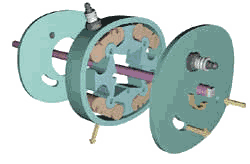
The Quasiturbine detonation combustion is a combination of
the best elements of other internal combustion engines:
(1) Quasiturbine detonation of the homogenous fuel/air charge eliminates the electronic ignition requirement of most fuel engines.
Electronic ignition in piston gasoline engine is required because of intake vacuum and incompatible long duration compression "pulse structure" limitations in the cylinder.
(2) Detonation will completely combust the fuel in the fuel/air charge because of the short, but powerful, pressure pulse
and because of the fast nearly linear variation of the QT maximum pressure zone, which rapidly closes and re-opens the combustion chamber. The diesel engine can only incompletely combust the fuel injected into the heated, compressed air in the cylinder. The QT (unlike the diesel) is therefore a "clean combustion" engine. It will have virtually no emission other than the standard products of combustion, e.g., CO2 and H2O. "Clean combustion" also implies that the QT engine is more fuel efficient than the diesel
engine.
(3) Detonation in the QT occurs rapidly at top dead center. In the diesel engine, ignition of the injected fuel occurs somewhat after top dead center, usually about 12 degrees or so, and is progressive with time to mechanically protect the piston. The QT's power stroke is therefore somewhat longer "with early and late mechanical energy conversion" and the exhaust somewhat cooler, which also implies a more efficient engine.
(4) Because the temperature of stator/rotor is not significant in Detonation mode (light ignition), and because the shorter QT pressure pulse is self-timing, premature ignition is not a concern. The combustion QT can have a very simple cooling mechanism, such as air cooling, even when operating on a low volatility fuel like natural gas.
(5) The Quasiturbine is suitable for multi-fuels,
including hydrogen combustion. It can also be operated in a combine thermal cycle mode (including steam and Stirling mode hook-up on the same shaft) thereby increasing further the efficiency.
(6) Finally, the Quasiturbine can operate in the more conventional Otto mode, yet retains its added value characteristics when compared to the piston engine.
For all these reasons, and considering what
it is intended to achieve, the Quasiturbine cannot be considered as a "rotary piston engine". Piston
paradigms do not apply to the Quasiturbine!
Advantages of Detonation
Detonation and hybrid are two different means to harvest the low
efficiency of reduced power piston engine, and both are compatible with
efficient electrical (in-wheel) power train. Detonation engine is however a more
direct and efficient way, and because the « on board fuel » is already a form of
energy storage, detonation engine avoid to re-stock this energy electrically
into batteries. The chemical energy stored in the fuel is degraded when
chemically re-stored in batteries.
The HCCI engine is always un-throttled, a high compression ratio is used
and the combustion is fast. This gives a high efficiency at low loads
compared to a conventional engine that has low efficiency at part loads. If an HCCI engine is used instead of an
ordinary gasoline engine in a car, the fuel consumption can be reduced to one half!
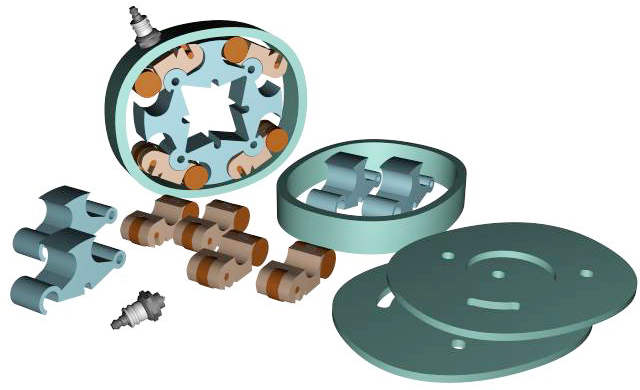
Another advantage is that the HCCI engine produces low amount of
nitrogen-oxides (NOx). The formation of nitrogen-oxides is strongly
dependent on combustion temperature. Higher temperature gives higher
amount of NOx. Since the combustion is homogeneous and a very lean
mixture is used, the combustion temperature becomes very low, which
results in very low amounts of NOx. The HCCI engine does not produce the
same levels of soot as the Diesel engine. The HCCI engine has much higher part load efficiency than the
conventional engine
and comparable to the Diesel engine, and has no problem with NOx and
soot formation like the Diesel engine. In summary, the HCCI engine beats
the conventional engine regarding the efficiency and the Diesel engine regarding
the emissions. Not only the photo-detonation suppresses the
energy consuming butterfly vacuum intake valve and so preserving the
engine efficiency at low power, but since it requires a much higher compression ratio,
it does increases the engine efficiency at full throttle as well.
Low Load Efficiency Penalty
At low load factor, the intake depressurization of the Beau de Rocha (Otto) cycle
dissipates power from the engine since the throttle valve is almost closed and
the descending piston acts as a clogged vacuum pump against the atmospheric pressure,
which vacuum is subsequently partially destroyed
while in the piston by fuel vaporization during the compression. Due to this effect, the
engine in Otto cycle opposes to all RPM revolution and its increases (well known as the
engine compression braking) and this intrinsic resistance to speed augmentation
is compensated by a constant and important fuel consumption.
The detonation mode does not use any
throttle valve and accepts without constraint all available air at atmospheric
pressure (similarly as the Diesel, where the pressurization energy is restituted
at the time of relaxation). For this reason, the efficiency at low load factor
of the detonation engine is twice that of the conventional Otto cycle, and
considering that the load factor of a car is in average about 10 to 15%, this
is not a small difference (saving is still superior in the traffic jams...).
Over the Hybrid Concepts
The detonation engine
suppresses all interest and need for hybrid vehicle concepts,
since a powerful detonation engine would have a small low regime
efficiency penalty, and the objective of hybrid is exactly to harvest the
present low regime efficiency penalty of the piston engine! Only about 50%
of this potential can be harvested the hybrid way.
Detonation and hybrid are two different means to harvest the low
efficiency of reduced power piston engine, and both are compatible with
efficient electrical (in-wheel) power train. Detonation engine is however a more
direct and efficient way, and because the « on board fuel » is already a form of
energy storage, detonation engine avoid to re-stock this energy electrically
into batteries. The chemical energy stored in the fuel is degraded when
chemically re-stored in batteries.
A Must for Hydrogen
In order to do work on a piston, the fuel-air mixture needs to burn at
a speed faster than the piston is moving. Low hydrogen flame speed is a
disadvantage shared with most other gaseous fuels. For comparison, a
gasoline-air mixture has a flame front speed that ranges typically from 70
up to 170 feet/second in IC engines, while an ideal hydrogen-air mixture
has a flame front speed of about 8 feet/second. An average vehicle engine
rotating at 2,000 rpm (33 revolutions per second) produces piston linear
speed of 45 feet/second in the middle-stroke, which is already 5 times
faster than the hydrogen flame front speed ! The fact that a hydrogen-air
mixture has a flame front speed of about 1/10 that of a gasoline-air
mixture contributes to explain why hydrogen engines only run at reduced
power and low rpm under load. However, the detonation mode is
extremely rapid and totally removes this limitation. This is why the
detonation mode (not compatible with piston, but with the Quasiturbine) is critical for the future of the hydrogen engine.
Quasiturbine QT50AC
As a first step, small experimental machine has been made. A larger
machine (or a better built one) would be suitable to sustain operation.
Quasiturbine QT50AC - Basic drawings and photos
Quasiturbine QT50AC : Calculated torque, power
and consumption

QT50 (AC with carriages) is intended for detonation mode,
where high surface-to-volume ratio is
an attenuating factor of the violence of
the detonation.
The Quasiturbine family of
engine uses no sinusoidal crankshaft movement, and allows for carriages which permit to
shape the volume pulse more appropriately than the piston for detonation. Shorter pressure impulses with linear ramps permitting to
self-trigger
thermal and photonic ignition and to overcome
the obstacles limiting the high engine compression ratio, so increasing the efficiency,
while maintaining the uniform combustion capability and simultaneously reducing the
polluants. Since the combustion is initiated by the radiation and the
pressure pulse is much shorter, the shape of the combustion chamber and its
carriages high surface / volume ratio helps attenuate the violence of
combustion.
Quasiturbine with turbo compressor or turbocharger, would not effectively recycle the waste heat of combustion
because energy spent in increasing the intake charge
does increase the specific engine power, but does not substantially affect the efficiency...
With natural gas or volatile, the Quasiturbine true photo-detonation mode would not require any added liquid fuel.
More Technical
March 2003 - MIT Engine Study
Engine Problematic and the
Quasiturbine
|